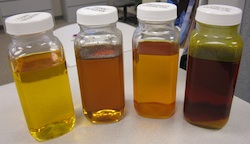 The synergies between the biodiesel, ethanol and advanced biofuels industries are growing. One of the things that’s been happening over the past few years is the ethanol industry creating a new feedstock for the biodiesel industry – inedible corn oil.
The synergies between the biodiesel, ethanol and advanced biofuels industries are growing. One of the things that’s been happening over the past few years is the ethanol industry creating a new feedstock for the biodiesel industry – inedible corn oil.
Inedible corn oil was one of the feedstocks that REG highlighted during USDA Ag Secretary Tom Vilsack and EPA Administrator Lisa Jackson’s biodiesel plant tour in Newton, IA. To learn more, I spoke with David Elsenbast, vice president of supply chain management for REG.
“Our industry is always looking for new, commercialized feedstocks to meet our growing Renewable Fuels Standard (RFS2) requirements for biodiesel. We are trying to produce nearly 800 million gallons of biodiesel this year,” said Elsenbast. “We typically use the traditional feedstocks, animal fats, waste cooking oil, and of course soybean oil. We’ve been working for several years now with the ethanol industry to create a market, and a market that has good value for the ethanol producer, to provide them a reason to separate the oil out of the DDGs and sell that to the biodiesel industry.”
Listen to my full interview with David Elsenbast: Cornoil - A Growing Feedstock for REG
As demand for biodiesel feedstocks continue to grow, the market for inedible corn oil continues to grow. Today, about one-third of the corn ethanol industry has corn oil extraction technology. The amount of inedible corn oil in the market will grow significantly now that POET has announced its corn oil extraction technology, VOILA. The company intends to install the technology in all 27 plants this year.
Yet despite its growing availability, not all biodiesel facilities have the technology to convert corn oil into biodiesel. Elsenbast explained that it’s harder to convert. There are components such as oil waxes and sterols and free fatty acids that must be removed before it can be converted into biodiesel. The free fatty acids are part of the oil due to the  heat that happens to the oil as it goes through the fermentation process. But REG has put into many of its plants the ability to pre-treat difficult to use fats and oils so they can make them biodiesel ready.
heat that happens to the oil as it goes through the fermentation process. But REG has put into many of its plants the ability to pre-treat difficult to use fats and oils so they can make them biodiesel ready.
“We have that capability today and we have plenty of capacity and we look forward to the time the ethanol industry puts this throughout all of their plants,” said Elsenbast. “As more and more corn oil comes onto the market, the biodiesel industry will step up, and we have stepped up in the past, and put in more production capabilities that can deal with corn oil.”
Inedible corn oil has environmental benefits over other feedstocks. Places like California under the Low Carbon Fuels Standard, are starting to rank biodiesel fuels (and all other fuels) on their carbon intensity scores. Corn oil is one of the lowest, if not the lowest rated carbon intensity feedstocks that can be converted into biodiesel.
I asked Elsenbast if there is enough feedstock available to meet the 800 million RFS2 goal. He said that in the past the industry produced nearly that amount using soybean oil and waste fats and with the emergence of new feedstocks such as corn oil and waste cooking oils, there is not only enough feedstock to meet 2011 numbers, but the nearly 1 billion gallons of biodiesel that will be required for 2012.
Click here to see photos from the USDA/EPA REG biodiesel plant briefing and tour.

